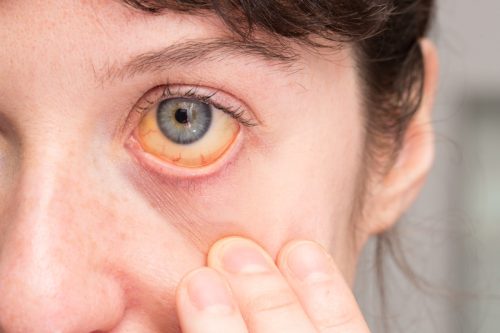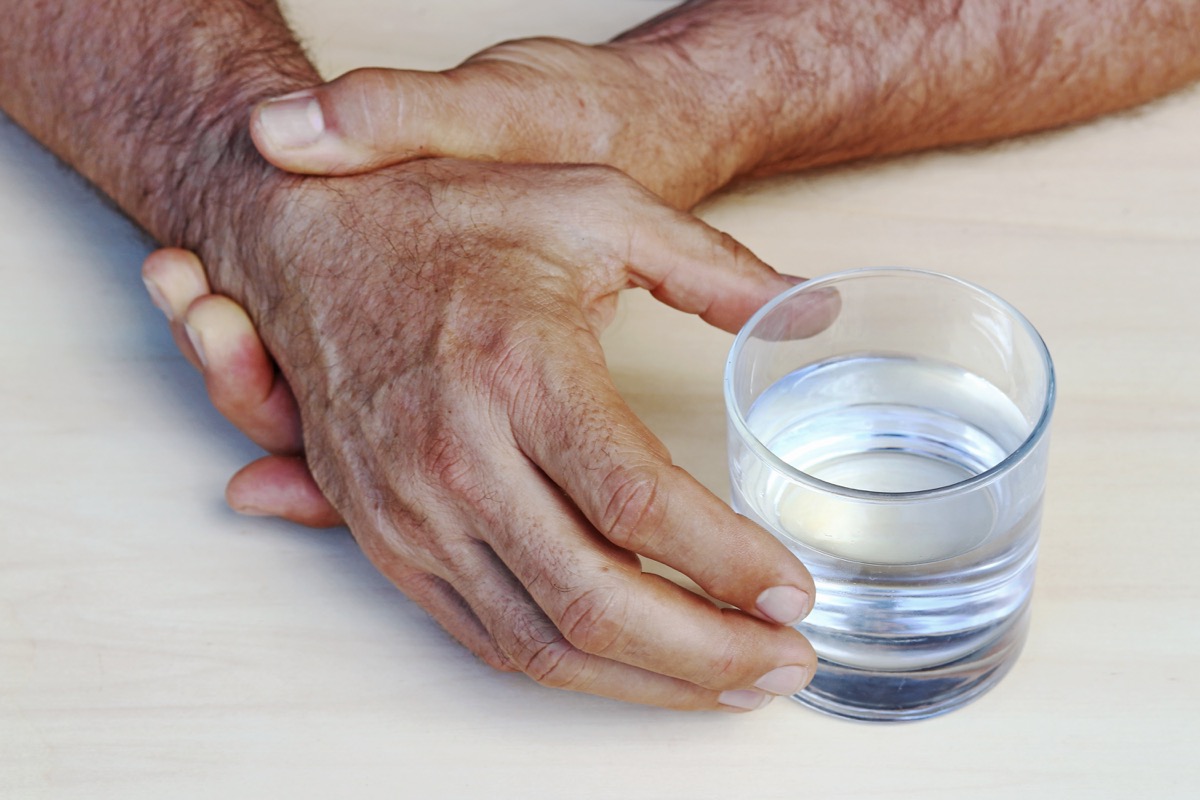50 Subtle Health Symptoms You Should Never Ignore

Most doctors worth their weight in medical degrees agree that maintaining a balanced diet, leading an active lifestyle, and scheduling regular checkups will put you on the right track when it comes to your health. But the truth is, healthy living can only do so much.
Knowing our bodies well and recognizing when something isn’t right is key to wellness. That may be more easily said than done, however: Signs of serious health issues can be subtle in the early stages, when intervention is typically most successful. Whether you’ve noticed changes to your mood, sleep patterns, weight, or even your handwriting, recognizing certain near-silent symptoms in time can clue you in to potentially-serious sicknesses. In fact, doing so might even save your life.
Read on for 50 signs that something could be seriously wrong—and schedule a check-up with your healthcare provider if you’re experiencing any of them.
READ THIS NEXT: This Is the No. 1 Heart Attack Symptom People Ignore, Doctors Say.
1
Itchy skin

Itchy skin is usually pretty straightforward, frequently stemming from a reaction to external irritants, dryness, or even a minor sunburn. However, in some cases, itchy skin is indicative of deeper systemic conditions related to your kidneys and liver. According to this 2015 study from the British Journal of General Practice, itchy skin can indicate kidney failure, blood diseases including lymphoma and leukemia, and liver diseases such as primary biliary cirrhosis.
If you feel the frequent need to scratch, but there’s no visible rash, it’s time to speak with your doctor about the possibility of a more serious underlying issue.
2
Rib pain

According to the Centers for Disease Control and Prevention (CDC), one in three people will develop shingles in their lifetime, and an estimated one million cases of shingles are diagnosed in America each year. But despite its prevalence, one of its major symptoms is very often overlooked: rib pain.
“Often patients think they injured a rib or have a kidney infection because they have pain over the area, when in fact it is the early stages of shingles,” explains Kristine Arthur, MD, a board-certified internist at MemorialCare Orange Coast Medical Center in Fountain Valley, California.
3
Stiff neck

Though neck stiffness can come from ailments as ubiquitous as stress, poor posture, or a simple muscular strain, it can also be something far more damaging. According to a 2011 study in the journal Current Reviews in Musculoskeletal Medicine, neck stiffness can also indicate a degenerative cervical spinal disorder, which affects up to two-thirds of the population in their lifetime.
If left untreated, this can lead to permanent nerve damage, compression of the spinal cord, paralysis, and in rare cases, death. So if your neck pain won’t go away, get it checked out by a professional.
READ THIS NEXT: Selma Blair Reveals the Early MS Sign She Didn’t Know Was a Symptom.
4
Changes in personality

Of course you can expect some fluctuation in your mood from day to day, depending on what’s happening in your life, but if you or the people around you notice any abrupt personality changes that aren’t preceded by a major life change, it may be due to a medical cause.
According to the Merck Manual, a doctor can help you evaluate whether the culprit is a mental health issue, a side effect of medication, the byproduct of a neurological health problem, or the result of another body-wide health concern, such as low blood sugar, a thyroid problem, or even lupus.
5
Joint pain

Many of us assume joint pain is just a natural part of the aging process, and for that reason, we tend to neglect to call the doctor when this symptom presents itself. But joint pain can severely limit your mobility and overall health—a 2018 report in the journal Geriatric Nursing suggests that “higher levels of mobility limitation were strongly associated with negative health outcomes.” In other words, regardless of the cause, maintaining mobility is key to your overall health and wellness.
The study explains that more than 30 percent of mature adults are categorized as having “limited mobility,” increasing the demographic’s risk of falls, poor psychological health, and obesity, which in turn increases their risk of diabetes, heart disease, certain types of cancer, and a range of other serious health concerns. When in doubt, ask your doctor about your joint pain before it takes a toll on your overall health.
6
Forgetfulness

Everyone is forgetful sometimes. But Verna R. Porter, a neurologist and director of the Alzheimer’s Disease Program at Providence Saint John’s Health Center in Santa Monica, California, explains that people should be aware of when that forgetfulness can be a sign of dementia.
Porter suggests that a decline across two intellection abilities—like language, abstract reasoning, judgment, or memory—may be a sign of dementia. So make sure to get in touch with your doctor if these symptoms are affecting your day-to-day life.
7
Changes in handwriting

If you notice changes in your handwriting—in particular major changes to your signature—you may be detecting a subtle symptom of a neurological disorder. In particular, changes in handwriting can be the result of Alzheimer’s disease, brain tumors, and Parkinson’s. While Alzheimer’s and tumors are more likely to be associated with increasingly illegible, scrawling handwriting, a 2017 study in the journal Movement Disorders Clinical Practice explains that Parkinson’s patients more typically demonstrate micrographia, or writing in a notably smaller print.
In fact, many last will and testaments have been successfully contested on the basis of handwriting—where a party argues that a change in signature style indicates that the deceased was no longer of sound mind while writing the terms of the document.
8
Lower right side stomach pain

The most common explanation for abdominal pain is digestive problems, but if the pain is contained in the lower right side, you might be looking at something much more serious: appendicitis.
According to a 2015 study in The Journal of The Canadian Chiropractic Association, appendicitis can frequently fly under the radar due to the subtlety of the pain level some patients experience; one patient in the aforementioned study described his pain as a 2/10 before being rushed to the hospital for an emergency appendectomy! If you notice this symptom, it’s time to call the doctor—even if the pain feels manageable at the moment.
9
Cramping in hot weather or during exercise

“In the simplest terms, heat illness arises when the body’s core temperature rises past a functioning threshold, and is unable to cool itself down,” explains Bert Mandelbaum, a sports medicine specialist and orthopedic surgeon and author of The Win Within: Capturing Your Victorious Spirit.
“During exercise, our body temperature increases, and needs to be brought back down to normal, and the body naturally does that by sweating. But when you add in extremely hot weather, humidity, and strenuous exercise, it becomes much more difficult for the sweat to evaporate and the body’s temperature can begin to rise past normal limits.” While cramping may not necessitate a call to the doctor on its own, it is a reminder that you should slow down before pushing yourself to the point of heat stroke.
10
Persistent pelvic pain or pressure

“The unfortunate truth is that there are no ‘early’ symptoms or signs that are specific for ovarian cancer,” explains Steve Vasilev, the medical director of Integrative Gynecologic Oncology at the John Wayne Cancer Institute in Santa Monica, California. Yet in cases where women are later diagnosed with the life-threatening illness, pelvic pain is at the top of the list of common symptoms experienced.
“The best advice rests with knowing your body and appreciating subtle changes,” Vasilev says. “Go back for re-evaluation if symptoms persist, or get a second opinion.”
11
Painful bloating

Sometimes bloating is caused by something as simple as PMS, a heavy meal, or even a case of food poisoning. But if you’re a woman that experiences regular, painful bloating outside of your menstrual cycle, you could be experiencing a symptom of endometriosis, a painful condition that can cause infertility.
Sherry Ross, MD, OB/GYN and Women’s Health Expert at Providence Saint John’s Health Center, explains that women experiencing bloating should also be on the lookout for other symptoms that can help identify endometriosis, including painful bowel or urinary issues, pain in the lower extremities, chest pain, and difficulty conceiving.
12
Bleeding between periods

Mild bleeding between periods, also known as spotting, is considered a normal (if somewhat uncommon) part of ovulation, and can be accounted for with fluctuations in estrogen levels. But according to Ross, heavier bleeding between menstruation can also be a sign of polycystic ovarian syndrome (PCOS), a condition that affects five to 10 percent of women and can cause infertility and excruciating pain.
“Your periods can come every two weeks, every three to six months, or once a year,” she explains. Ross recommends a trip to the doctor if your periods are arriving more frequently than every 21 days, or if you go more than 45 days between them.
13
Excessive bruising

As skin becomes thinner with age and fat stores deplete, it’s not unusual to discover that you bruise more easily than you used to. But according to the Mayo Clinic, this can also point to a bigger issue if you notice that the bruises are large, happen frequently with no known injury, or have come on suddenly. In these cases, those black and blues may indicate hemophilia, or an inability for the blood to clot.
This might be due to abnormal blood platelets or a problem with a set of proteins called “clotting factors.” People with a history of excessive bruising or bleeding should speak with a doctor about it, or they otherwise run the risk of dangerous internal bleeding.
14
Pain in you calves, arms, or hips

Deep vein thrombosis (DVT) is a dangerous, sometimes life-threatening condition—and one that frequently goes undiagnosed, according to the U.S. Department of Health. DVT occurs when a patient experiences a blood clot in a deep vein—most frequently in a person’s calves (though it can also happen in arms or hips). It can lead to pulmonary embolism if it travels through the bloodstream and creates a blockage in the lungs. That’s why you should always take it seriously if you notice tenderness, swelling, redness or pain in those areas where DVT most commonly strikes.
15
Dry eyes

Dry eyes may be the result of aging, a side effect of medication, or related to a change in the weather. But California-based surgical neuro-opthalmologist Howard R. Krauss, MD, warns that it can also be a sign of a metabolic disorder, such as diabetes, a neurodegenerative disorder, such as Parkinson’s disease, or a sign of autoimmune disease, such as lupus, rheumatoid arthritis, scleroderma, Sjogren’s syndrome, or Graves’ disease.
He notes that prolonged dry eye, especially with redness or pain, may be a sign of corneal breakdown and calls for medical intervention to prevent permanent damage to the eye(s).
16
Vision changes and increased clumsiness

Changes in vision can be a normal part of aging, or the toll of too much screen time in a technology-addicted era. But vision problems can also indicate the serious but subtle neurological effects of tumors, according to Santosh Kesari, a neuro-oncologist, neuroscientist, and chair of the Department of Translational Neurosciences and Neurotherapeutics at the John Wayne Cancer Institute. That’s why it’s important to look out not only for blurriness or noticeably impaired vision, but also for increased clumsiness or accidents that might indicate slightly under-functioning eyesight.
“Patients may or may not be aware of vision loss with brain tumors,” he explains. “They may keep bumping into things on the side of body related to the vision loss and/or have repeated car accidents on the side of the loss.”
17
Yellow eyes

If you notice that the whites of your eyes aren’t looking quite so white lately, it’s time to call the doctor and request a screening for jaundice. While jaundice itself does not necessarily need to be treated in adults, the root cause could be something far more nefarious, like hepatitis, gallstones, or tumors, according to the Cleveland Clinic. And if that yellowing is accompanied by a fever or abdominal pain, make sure to get seen immediately.
18
Unintended weight loss

In theory, plenty of people out there would be thrilled to see those numbers on the scale go down without any effort—but if your weight loss can’t be explained by changes in your diet or exercise regimen, this symptom could indicate a whole host of underlying health problems. According to the Mayo Clinic, sudden, unexplained weight loss could mean cancer, heart failure, HIV, Parkinson’s, tuberculosis, diabetes, and more. Whatever the cause, you’ll want to get to the bottom of it with the help of a medical professional.
19
Sudden weight gain

Similarly, rapid weight gain without a change in your eating or exercise habits can be a cause for concern. Yes, most weight gain can be explained by an increase in calories, less physical activity in your daily routine, or the normal slowing of one’s metabolism, which happens with age—not necessarily a more serious medical condition. But it could also be related to hypothyroidism, polycystic ovarian syndrome, or a problem with your digestive tract, according to Harvard Medical School.
20
Feeling full quickly

If you find that eating small amounts leaves you with the feeling of a full stomach, this may be a subtle sign that something is off in your esophagus or stomach: in particular, gastroesophageal reflux (GERD), stomach ulcers, and occasionally, pancreatic or stomach tumors, according to the Medical University of South Carolina. In these cases, the sensation of early satiety comes from having a physical obstruction that pushes your food higher in your digestive tract—so don’t ignore that sudden reduction in your hunger cues.
21
Shortness of breath after eating

Shortness of breath should always be a red flag. But if you experience this particular symptom after eating, chances are you have one of two things: a food allergy, or hiatal hernia. A food allergy should be tended to immediately, especially if this is the first encounter you’ve had with a new food, as things have the potential to escalate quickly in cases of anaphylaxis.
A hiatal hernia is an often undetected condition in which the stomach herniates through the diaphragm. “In some very large paraesophageal hernias, the stomach may push on the diaphragm or compress the lungs contributing to a sensation of shortness of breath,” according to the Medical College of Wisconsin. The fact that you’re experiencing symptoms at all means intervention will likely be necessary—potentially even surgery.
22
Night sweats

If you wake up in the night drenched in sweat even though you keep the thermostat down, you won’t want to ignore this symptom. According to a 2012 study in the Journal of the American Board of Family Medicine, the sweating could be the result of a range of conditions, including nervous system disorders, spinal cord issues, trauma, and abnormally high levels of carbon dioxide in your blood. It can even be the result of untreated anxiety, so make sure to talk to your doctor if this symptom arises.
23
Sudden snoring

If you’ve never been particularly prone to snoring, but you (or your partner) have noticed a change, you may be displaying the early signs of sleep apnea. Sleep apnea is a condition in which your breathing repeatedly stops and starts during sleep, leaving you vulnerable to fatigue, high blood pressure, heart disease, type 2 diabetes, and more. If you find that you snore loudly, awaken suddenly, are gasping for breath when you wake up, feel tired even after sleeping a normal number of hours, or have a very dry mouth in the morning, these can all be signs that it’s time to talk to a doctor.
24
Exhaustion

Between careers, family commitments, friendships, and other responsibilities, many of us are spread too thin these days. That’s what makes it so hard to tell the difference between run-of-the-mill exhaustion and something far more serious. According to a 2015 report from the Institute of Medicine, an estimated 836,000 to 2.5 million Americans suffer from chronic fatigue syndrome (also known as myalgic encephalomyelitis) but have not been diagnosed. If you suspect your exhaustion is more than just the result of a few too many late nights, talk to your doctor before your symptoms get worse.
25
Sleep disturbances

Sleep disturbances can happen for a lot of reasons: stress, anxiety, or physical discomfort can trigger unwanted wakefulness in even the best sleepers. But sometimes sleepless nights point to a more serious issue—and the possible causes run the gamut from respiratory problems to thyroid disease to Parkinson’s. If the changes in your sleep patterns are making it difficult to get through the day, a doctor can help you determine the cause.
26
Lower back pain on one side

If you experience pain on one side of your back, don’t ignore it—it could be a kidney stone.
“Pain arises when the stone moves from the kidney into the ureter, the small tube that transports urine from the kidney to the bladder,” explains S. Adam Ramin, MD, urologic surgeon and medical director of Urology Cancer Specialists in Los Angeles, California. “If the stone blocks the passing of urine in one—or both—of these tubes, the urine will begin to back up into the bladder, causing swelling and pain, which can be accompanied by nausea and vomiting, sharp, cramping pain in the lower back and abdomen—that usually comes in waves as the body tries to rid itself of the stone—and an intense urge to urinate.”
27
Frequent headaches

While headaches can happen for a wide range of reasons and are not always cause for alarm, they can also be a sign of a tumor. “Headaches are very common and difficult to associate with tumor, but changes in frequency, type, or intensity of headache should prompt neurological evaluation,” Kesari explains. “Headaches typically are due to the tumor size and growth rate. So larger tumors and faster growing tumors cause an increase pressure in the brain resulting in activation of pain receptors on the coverings of the brain, resulting in headache.”
28
Dizziness

People tend to lump lightheadedness and dizziness into the same category and use the words interchangeably, but these two similar feelings can indicate totally different underlying conditions. While lightheadedness typically means you’re dehydrated, hungry, overtired, or experiencing an unpleasant side effect of a medication, dizziness is frequently associated with some more serious concerns, like vertigo, tumors, strokes, and inner ear infections or diseases.
According to a 2011 study published in the journal Neurology Clinical Practice, one of the key symptoms practitioners look for to distinguish between the two is oculomotor abnormality. In other words, wave your fingers in front of your face. Does it look to you like you have more than five fingers on your hand? If so, don’t ignore this symptom—it’s time to call a doctor for a full evaluation.
29
Chest pressure

“Most people wrongly believe that heart attacks are always accompanied by severe chest pain. This is not true,” says California-based cardiologist Richard Wright. “Although it is possible to have severe chest pain during heart injury, most of the time the signs and symptoms are more subtle.”
So, what do people typically experience instead? “Oppressive discomfort and a heavy feeling that they don’t call ‘pain,’ most often located in the center of the chest,” explains Wright. Call a doctor immediately if you feel chest pressure, or an emergency line if you suspect a heart attack.
30
Irregular heart rate

If you notice a fluttering feeling in your chest, don’t wait to get to the doctor. According to Shephal Doshi, director of cardiac electrophysiology at Providence Saint John’s Health Center, this symptom is a key indicator of atrial fibrillation (AFib)—a condition that can lead to blood clots, strokes, and heart failure.
“The American Heart Association estimates that nearly 3 million Americans currently have atrial fibrillation,” says Doshi. “In general, the common symptoms include fatigue, symptoms of rapid or irregular heart action, palpitation, lightheadedness, and shortness of breath, just to name a few.”
31
Bleeding when you floss

If you display signs of gum disease, including red or swollen gums, bleeding while brushing or flossing, loose teeth, receding gums, or mouth sores, it’s time to bite the bullet and finally see a dentist. What starts as gingivitis—a form of plaque buildup that irritates the gums—can lead to gum disease, and, according to a 2006 study published in the journal Odontology, gum disease is connected with an increased risk of heart disease, stroke, diabetes, respiratory diseases, and osteoporosis.
32
Dry eyes and mouth

Don’t ignore your symptoms if you experience the combination of dry eyes and mouth. While each of these symptoms is fairly innocuous on its own, a pairing of the two may be an indication of Sjögren’s Syndrome, an autoimmune disease that affects your mucus membranes and glands. Sjögren’s commonly accompanies more serious conditions, like lupus and rheumatoid arthritis, so make sure to tell your doctor if you’re dealing with these symptoms.
33
Changes in taste and smell

A 2017 study in the Journal of Neurogastroenterology and Motility confirmed what those with gastroesophageal reflux (GERD) already know—when you suffer from GERD, food simply doesn’t taste or smell the same. Many with GERD report decreased enjoyment while eating, and the change in their experience correlates with the severity of their condition. If you notice that your tried and true culinary staples begin to taste a bit off, or the flavors are a shadow of what you remember them to be, don’t ignore this symptom.
34
Sudden weakness

Though physical weakness can be the result of nerve damage, muscular or skeletal degeneration, or a neuromuscular disorder, Kesari warns that in some cases, it can also be the result of a tumor.
“If a brain tumor is in the frontal lobe motor cortex or affects the motor fibers—these are the neurons and pathways that control the muscles—then patients can present with weakness of an extremity,” he explains. “This usually indicates the location of the tumor as well.” To determine whether or not your physical weakness is this worst-case scenario or not, consult a doctor about your sudden change in strength.
35
Insatiable thirst

Diabetes symptoms are often subtle, which is why experts estimate that there are millions of undetected cases of diabetes in America today. Type 2 diabetes is particularly difficult to identify because of how gradually the symptoms present, making it crucial to clue yourself in to your body and be in tune with minor changes. At the top of the Mayo Clinic’s list of possible diabetes symptoms is extreme thirst and frequent urination, especially if they are accompanied by other symptoms, like fatigue, weight loss, blurred vision, swollen gums, slow-healing sores, or increased hunger.
36
Lumps in breast tissue

On paper, finding a lump in your breast may seem like an obvious red flag. But the reality is that in most women, breast tissue is naturally lumpy, which can make abnormalities far more difficult to detect than people realize. Richard Reitherman, the medical director of breast imaging at MemorialCare Breast Center at Orange Coast Medical Center in Fountain Valley, California, points out that “findings may be noticeable in only one position,” and there’s no one thing you should be looking for.
“Masses can feel like a hard marble and be mobile, or be less defined and non-mobile or fixed,” he says. The key is to do at-home exams frequently, schedule annual mammograms, and contact your doctor immediately if you notice anything new.
37
Lumps in your armpit

Janie Grumley, a breast surgical oncologist, Director of the Margie Petersen Breast Center at Providence Saint John’s Center, and Associate Professor of Surgery at John Wayne Cancer Institute, says that women should also be on the lookout for any subtle lumps in the armpit. Even small, painless lumps can be a sign that cancer has affected the lymph nodes.
38
Breast tenderness

While hormonal changes related to menstruation or pregnancy frequently cause breast tenderness, Reitherman explains that women should keep a keen eye on this symptom, especially if it’s accompanied by changes in the nipples, including in color or texture. Don’t be afraid to let your doctor know that what you’re experiencing isn’t normal for you. Reitherman says it’s important to get to the root of your symptoms with “follow-up imaging examinations and doctor visits, or a biopsy consultation with a specialist.”
39
Growth of breast tissue in men

Gynecomastia, or the growth of breast tissue in men, can be the result of normal hormonal changes and is not typically a cause for alarm on its own. However, in some cases, men experience this bodily change as the result of other illnesses, which is why it’s worth mentioning to your doctor—especially if you’ve noticed any other shifts in your body. According to the Mayo Clinic, enlarged breast tissue can be the result of hypogonadism (categorized as any condition that interferes with the production of testosterone), adrenal or pituitary tumors, hyperthyroidism, kidney failure, or liver failure.
40
Pain in your right upper quadrant

While any pain in your abdomen can be the result of a serious condition, pain in the right upper quadrant (RUQ) should always prompt a call to the doctor as it can indicate anything from a liver abscess to Hepatitis C.
According to a 2018 study published in the journal RadioGraphics, one third of patients initially diagnosed with acute cholecystitis (the most common culprit for RUQ pain) later found another underlying cause for their discomfort. This is yet another reason why you should always call a doctor instead of ignoring this symptom or attempting to manage the pain yourself.
41
Pain between the shoulder blades

Typically gallstones are identified when patients complain of a stabbing pain in the upper abdomen. But gastroenterologist Rudolph Bedford warns that people should also be aware that sometimes the discomfort can present even higher, between the shoulder blades.
“Gallstones are the product of cholesterol and bile, and this may result in infection, irritation, and inflammation,” he explains. “Gallbladder removal is one of the most common surgeries in the U.S. and is the main treatment for removing gallstones.” Unfortunately, all too often this symptom is misattributed to a back injury, resulting in delayed treatment and unnecessarily prolonged pain.
42
Belching

Not only is belching unpleasant for you and those around you, it can also be a sign of a major digestive problem, according to Bedford. If paired with vomiting, sore throat, heartburn, cramping, or bowel problems, plan to seek medical advice. Bedford says that the most common causes for digestive issues are GERD, irritable bowel syndrome, celiac disease, diverticulitis, gallstones, and ulcerative colitis—all of which warrant medical intervention.
43
Peeing when you laugh or sneeze

If you suffer from urinary incontinence, you may be tempted to ignore it out of embarrassment. But Ramin notes it’s very common: “Millions of women deal with some type of bladder control issue at some point in their lives,” he says.
The good news? It doesn’t mean you’ll end up in adult diapers. According to Ramin, by making certain dietary and lifestyle changes, you can regain bladder control that you had previously lost—but the first step is calling a medical professional.
44
Nausea with abdominal pain

While nausea on its own can be a symptom of everything from food poisoning to pregnancy, nausea paired with abdominal pain—especially pain that gets worse after eating—should never be ignored. You could be experiencing pancreatitis, which occurs when your pancreas becomes inflamed by your digestive enzymes. Other symptoms include unexpected weight loss, tenderness in the abdomen, and changes in your bowel movements. Unfortunately, serious complications can arise from untreated pancreatitis, including infection, kidney failure, and breathing problems. It is also considered a risk factor for pancreatic cancer, so a full workup from a doctor is prudent.
45
Numbness in hands or feet

It may be tempting to ignore the tingling or numbness in your hands and feet—it doesn’t really hurt, after all. But this symptom could be pointing to a range of issues, some of them serious, and the only way to rule those out is with the help of a doctor. If you’re lucky, the tingling may be the result of a vitamin deficiency—something you should be able to easily address with dietary changes or supplements.
However, numbness and tingling are also frequently associated with diabetes and certain kidney conditions, and these symptoms may even be the result of certain types of cancer, including spinal cord tumors, myeloma, prostate cancer, acute lymphocytic leukemia, and advanced-stage lung cancer.
46
Low libido

According to NHS Scotland, loss of libido affects one in five men—and far more women—over the course of their lifetime. It can be the result of a range of medical conditions, hormonal shifts, psychological and emotional factors, and relationship problems. Whatever the cause for your lowered sex drive, it merits your attention if it’s affecting your life.
47
Unsteady gait

The gait of your step is almost like your body’s signature, which is why gait difficulty and changes can tip doctors off to neurological problems. According to Kesari, changes in your walking habits or abilities are “generally related to the frontal lobe, or cerebellum.” He explains that in the case of a tumor in this area, people may experience imbalance or irregular gait patterns. You’ll want to consult a doctor for a full neurological screening if you notice this symptom.
48
Tremors

Patients presenting with tremors are frequently diagnosed with a nerve disorder called essential tremor (ET). The Mayo Clinic indicates that essential tremor is “not usually considered a dangerous condition,” though symptoms tend to get worse and more difficult to manage over time. But, according to a 2006 study published in the Journal of the American Medical Association (JAMA), 37 percent of study participants—all of whom were diagnosed with ET—were actually misdiagnosed, and were later found to have either Parkinson’s or dystonia (an involuntary muscle movement disorder). That’s why tremors are cause not only to call a doctor, but also reason enough to seek a second opinion.
49
Uneven posture

According to Neel Anand, a professor of orthopedic surgery and director of spine trauma at Cedars-Sinai Spine Center in Los Angeles, California, uneven posture—meaning uneven shoulders, uneven hips, asymmetry of the back, or your head resting off-center—likely points to scoliosis. “One in 40 people will be affected by scoliosis, and anyone at any age is at risk,” he explains. “Although there is no age cut-off, signs and symptoms most commonly occur just before puberty, when the body experiences a growth spurt.” He urges that if the spinal curvature is more than 25 degrees, or if the patient experiences everyday discomfort, treatment is likely necessary.
50
Irregularly shaped moles

If your skin is prone to freckles or benign moles, looking for signs of irregularity that indicate melanoma can feel like looking for a needle in a haystack. That’s why the CDC has broken it down as simply as possible: you just have to remember your A-B-C-D-E’s: asymmetry, border, color, diameter, and evolving.
Any mole that has a jagged edge or irregularity, an uneven color, is larger than a pea, or is changing is worth getting checked out. And, as a general rule, any noticeable changes to your skin should never be ignored, so consult your doctor for a full screening if you see a suspicious spot suddenly crop up.
Best Life offers the most up-to-date information from top experts, new research, and health agencies, but our content is not meant to be a substitute for professional guidance. If you have specific health questions or concerns, always consult your healthcare provider directly.